Take Care Of Your Horse's Back
One of the most important areas of your horse’s anatomy is its back as it is where you sit and if painful or uncomfortable in any way, will effect how your horse feels when riding i.e. from being mildly uncomfortable and lacking performance to being very on-edge and dangerous to ride.
Over the horse's working life, which in some cases starts far too early when the skeleton is still too weak and immature to carry a rider and a saddle, much damage can occur to this part of their body but actually much can be done to help to prevent this damage both in your management system and in our work regime.
Below is a diagram of the horses skeleton for those who are not too familiar with it and it shows the spinal processes which grow upwards from the vertebral column and these bones need space between them as nature has so rightly provided, so that the horse can
- a) lift its back comfortably to carry a rider and work underneath its rider and
- b) to move sideways slightly when the horse turns etc.
Above this skeletal structure shown, there are strong muscles and ligaments (Longissimus dorsi being the main one). If these muscles and ligaments were to shorten in any way i.e. go into spasm or be made to shorten for postural or management reasons then we are actively causing a situation where we are allowing the muscles/ligaments to pull the spinal processes together thus causing pain and discomfort unnecessarily. The area circled shows this has happened as there is no longer any space between some of these bones and therefore they will start to rub causing pain and leading to sclerosis.
So what can be done
Firstly, in our daily management of our horse we can do a lot ourselves to ensure that we are not shortening these all important ligaments and muscles that run along our horses back by keeping his daily routine as close to nature as we can. He is not a giraffe and therefore has not been given a giraffe-like neck in order to eat the tops of trees and bushes. A horse is naturally used to eating from the ground. All hay and feed should be fed from there as many hours spent eating from a haynet tied halfway up the stable wall is creating shortening and tightening in the all-important back ligaments and muscles discussed above.
Please note in this diagram how the spinal processes underneath the saddle area are being pushed together so there is no longer enough space between the bones, causing them to rub and eventually become sclerotic and painful. This can be the beginning of back problems that so easily did not have to happen.

Clearly this horse will spend hours stretching the ligaments and muscles that protect his back from becoming shorter and more restricted as he is living his life more as nature intended him to do (as he would feed in the wild). All the spinals processes have space to move apart as you can see from the drawing.

Secondly, working our horses has a huge effect on the posture of the skeleton and can either greatly enhance and develop soundness and good health or it can unfortunately have the reverse effect. Working with or without a rider, some time spent stretching the structures through the back where we sit is time very well spent as it can only lengthen and stretch the ligaments and muscles that can and will pull the boney processes together if allowed. This diagram shows that working on the long-reins or ridden for some time to stretch the ‘topline’ is possible for all.




